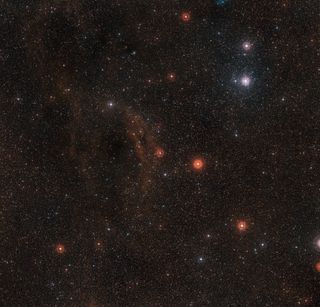Hypergiant Star's Weight Loss Secrets Revealed (Video)

A new view of one of the largest known stars in the Milky Way gives the skinny on how giant stars quickly lose mass near the ends of their lives, preparing for huge supernova explosions.
Massive stars that are close to the end expand dramatically into enormous red giants, and the gargantuan red hypergiant VY Canis Majoris, located around 3,800 light-years from Earth, is one of the biggest. As such stars expand, they eject huge amounts of dust and gas, but scientists have been unsure of the mechanism behind that exodus. A new video of VY Canis Majoris here offers a zoomed-in view on the hypergiant.
New observations from the Very Large Telescope at the European Southern Observatory (ESO) in Chilecaught VY Canis Majoris in greater detail than ever before as the giant star shed mass. The new views, captured with the SPHERE instrument on the Very Large Telescope, showed that the star has unexpectedly large dust grains that can be physically pushed away by the force of starlight. Those perfectly sized grains allow the star to expel a quantity of dust and gas from its surface each year equivalent to 30 times the mass of the Earth, ESO officials said in a statement. [See more amazing photos from ESO's Very Large Telescope]
"Massive stars live short lives," said Peter Scicluna, an astronomer at the Academia Sinica Institute for Astronomy and Astrophysics in Taiwan. "When they near their final days, they lose a lot of mass. In the past, we could only theorize about how this happened. But now, with the new SPHERE data, we have found large grains of dust around this hypergiant. These are big enough to be pushed away by the star's intense radiation pressure, which explains the star's rapid mass loss," he said in the ESO statement.
The SPHERE instrument uses a mirror-distorting process called extreme extreme adaptive opticsto correct images in the visible-light spectrum, giving the instrument a closer look at the star's surroundings without its extreme brightness distorting the picture. Using that view, the researchers were able to analyze how the dust and gas around the star reflect light. This allowed the scientists to divine the dust's properties, solving a mystery of how huge red giants are able to expel so much mass.

When a star runs out of hydrogen fuel to fuse within its core, it contracts and get hot enough to fuse helium into carbon instead. The force of that reaction drives the star to expand again into massive red giant star. If the star is huge enough, it will eventually implode after this stage and cause a powerful supernova blast.
The researchers found that the grains of dust surrounding the red hypergiant VY Canis Majoris were large, at around 0.5 micrometers across, which ESO officials said is 50 times larger than usual interstellar dust. This gives the grains enough surface area to actually be pushed away by starlight. The radiation the star beams out would pass through if the grains were any smaller, and a larger size would render them too heavy to push.
Get the Space.com Newsletter
Breaking space news, the latest updates on rocket launches, skywatching events and more!
Eventually, VY Canis Majoris will build up enough heavier elements at its core to implode, heating up to extreme temperatures and ultimately bursting outward into a massive supernova. That explosion, occurring hundreds of thousands of years from now, might look as bright as the moon from Earth, ESO officials said. What dust isn't destroyed in the blast will endure to help form new generations of stars.
Email Sarah Lewin at slewin@space.com or follow her @SarahExplains. Follow us @Spacedotcom, Facebook and Google+. Original article on Space.com.
Join our Space Forums to keep talking space on the latest missions, night sky and more! And if you have a news tip, correction or comment, let us know at: community@space.com.

Sarah Lewin started writing for Space.com in June of 2015 as a Staff Writer and became Associate Editor in 2019 . Her work has been featured by Scientific American, IEEE Spectrum, Quanta Magazine, Wired, The Scientist, Science Friday and WGBH's Inside NOVA. Sarah has an MA from NYU's Science, Health and Environmental Reporting Program and an AB in mathematics from Brown University. When not writing, reading or thinking about space, Sarah enjoys musical theatre and mathematical papercraft. She is currently Assistant News Editor at Scientific American. You can follow her on Twitter @SarahExplains.
